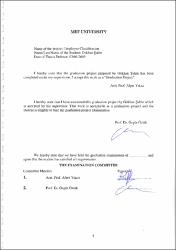Please use this identifier to cite or link to this item:
https://hdl.handle.net/20.500.11779/1191| Title: | Employee Classification | Other Titles: | Çalışan sınıflandırması | Authors: | Şahin, Gökhan | Advisors: | Yıkıcı, Alper | Keywords: | K Means Employee Classification Clustering Çalışan Sınıflandırılması Kümeleme |
Publisher: | MEF Üniversitesi, Fen Bilimleri Enstitüsü | Source: | Şahin, G. (2018). Employee classification, MEF Üniversitesi Fen Bilimleri Enstitüsü, İstanbul, Türkiye | Abstract: | Employee is an important element of the organization. The success or failure of the organization depends on its performance. In this study, there are solutions that affect the theoretical framework and models of employee development and employee performance. A hybrid procedure based on data clustering can be used by the authority to estimate the performance of employees in the next month. This study shows how to implement the data clustering method to evaluate the performance of the work in the decision-making process. This study is done to eliminate the effectiveness of inefficient work, inefficiency, and effective lack of work. The clustering analysis itself is not a specific algorithm, but a general task that needs to be solved. It can be achieved with various algorithms that differ significantly in their understanding of what constitutes a cluster and how it can be found effectively. Popular concepts of clusters include small distances between cluster members, dense areas of the data field, intervals, or certain statistical distributions. Clustering can therefore be formulated as a multipurpose optimization problem. The appropriate clustering algorithm and parameter settings (including parameters such as the distance function to be used, the density threshold, or the number of expected clusters) depend on the individual data set and the intended use of the results. Cluster analysis is not an automated task, but a recursive knowledge discovery process involving trial and failure, or an interactive multipurpose optimization process. As a result, it is usually necessary to modify the data preprocessing and model parameters until the desired properties are obtained. The intent of this study is to provide an assessment methodology for human resource professionals. Employee profiles play a crucial role in the evaluation process in order to improve the performance of the training process. In this article, we focus on clustering in specific categories that represent the characteristics of employees according to their profiles. In this study, it is used that employee project number, production time, customer note and quality ratio. As a result of the study, the most valuable data objects are project number and production time. Çalışan, organizasyonun kilit unsurudur. Organizasyonun başarısı veya başarısızlığı çalışan performansına bağlıdır. Bu çalışma, çalışan gelişimi ve çalışan performansı üzerindeki etkisi ile ilgili teorik çerçeve ve modelleri analiz etmektedir. Veri Kümeleme yöntemine dayanan karma prosedür, çalışanların bir sonraki ay için performanslarını tahmin etme yetkisi tarafından kullanılabilir. Bu çalışma, karar verme sürecinde çalışan performansını değerlendirmek için veri kümeleme yönteminin nasıl uygulanabileceğini göstermektedir ve verimsiz çalışanın, verimsizliğin büyüklüğünün ve nispeten işe yarar bir çerçeve ile verimsizliği ortadan kaldırmak için etki eden çalışan değerlerinin bulunmasına yardımcı olmaktadır. Kümeleme analizinin kendisi belirli bir algoritma değil, çözülmesi gereken genel görevdir. Bir kümelenmeyi neyin oluşturduğu ve bunların nasıl etkili bir şekilde bulunabileceği konusundaki anlayışların önemli ölçüde farklı olan çeşitli algoritmalar ile başarılabilir. Kümelenmelerin popüler kavramları arasında küme üyeleri arasındaki küçük mesafeler, veri alanının yoğun alanları, aralıkları veya belirli istatistiksel dağılımlar yer alır. Kümeleme bu nedenle çok amaçlı bir optimizasyon problemi olarak formüle edilebilir. Uygun kümeleme algoritması ve parametre ayarları (kullanılacak mesafe işlevi, yoğunluk eşiği veya beklenen kümelerin sayısı gibi parametreler dahil), tek tek veri kümesine ve sonuçların kullanım amacına bağlıdır. Küme analizi, otomatik bir görev değil, deneme ve başarısızlığı içeren yinelemeli bir bilgi keşif süreci veya etkileşimli çok amaçlı optimizasyon sürecidir. Sonuçta istenen özellikleri elde edinceye kadar, veri ön işleme ve model parametrelerini değiştirmek genellikle gereklidir. Bu makalenin amacı, insan kaynakları birimi için bir değerlendirme metodolojisi sağlamaktır. Çalışan profilleri, eğitim sürecinin performansını iyileştirmek için değerlendirme sürecinde çok önemli bir rol oynamaktadır. Bu çalışma, çalışanların özelliklerini profillerine göre temsil eden belirli kategorilerde kümelenmeye bulmaya odaklanmaktadır. Çalışma sonucunda en değerli veri nesneleri proje numarası ve üretim zamanıdır. |
URI: | https://hdl.handle.net/20.500.11779/1191 |
| Appears in Collections: | FBE, Yüksek Lisans, Proje Koleksiyonu |
Files in This Item:
| File | Description | Size | Format | |
|---|---|---|---|---|
| Gökhan Şahin.pdf | YL-Proje Dosyası | 953.87 kB | Adobe PDF |  View/Open |
CORE Recommender
Page view(s)
28
checked on Jan 20, 2025
Download(s)
18
checked on Jan 20, 2025
Google ScholarTM
Check
Items in GCRIS Repository are protected by copyright, with all rights reserved, unless otherwise indicated.